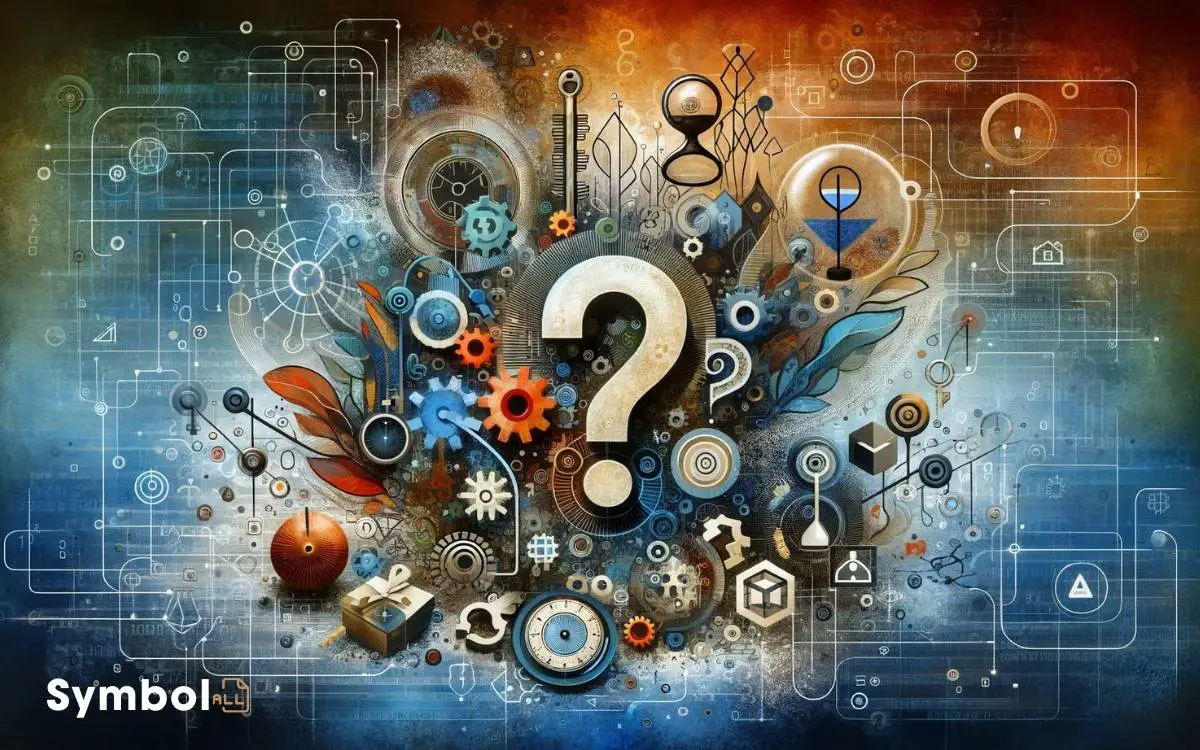What Is the Use of Symbol? Tangible Realities!
Symbols bridge abstract ideas and tangible realities, infiltrating every aspect of life from language to national flags. They compress complex ideas, conveying emotions, ideologies, and identities without direct articulation.
Acting as thought currency, symbols facilitate cross-cultural exchanges. Historically, symbols have encapsulated ideologies, shaping societal values and connecting modern societies to ancient pasts.
In religious contexts, they link divine to human, embodying deep spiritual meanings. Through visual communication, symbols transcend language barriers, conveying messages efficiently.
They’re essential for brand identity, political movements, and emotional expression. Understanding symbols unravels layers of human culture and interaction, inviting deeper engagement with how we communicate and perceive the world.

Key Takeaways
Defining Symbols
At its core, a symbol functions as a bridge, connecting abstract ideas or concepts to tangible representations, allowing for deeper understanding and communication.
You’ll find that symbols permeate every aspect of human life, from language and art to rituals and national flags. They serve not merely as tools for communication but as mechanisms for making complex ideas more accessible and digestible.
Through symbols, you’re able to convey emotions, ideologies, and identities without the need for explicit articulation. They encapsulate the essence of thoughts and objects, transforming them into a form that’s both interpretable and relatable.
In essence, symbols act as the currency of thought, facilitating an exchange of ideas across different cultures and time periods, thus enriching human interaction and understanding.
Historical Significance
You’ll find that the origins of ancient symbols reveal a complex tapestry of human expression and communication.
Their cultural impact over time demonstrates a fluid evolution, shaping and being shaped by societal values and beliefs.
In religious contexts, symbols serve as pivotal conduits for spiritual narratives, embodying doctrines and facilitating communal identity.
Ancient Symbols Origins
Throughout history, ancient symbols have served as the cornerstone of human communication, embodying complex ideologies and cultural narratives that transcend verbal language.
These symbols have origins deeply rooted in the earliest human societies, where they functioned not only as means of representing the tangible world but also the intangible concepts of faith, authority, and community.
They’ve emerged from the natural human inclination to assign meaning to patterns and shapes, evolving into sophisticated systems of representation that encapsulate the essence of civilizations.
The study of these symbols reveals their role in ritualistic practices, governance, and social cohesion, highlighting their importance in establishing shared identities.
Understanding their origins allows you to grasp the foundational layers of human expression and the universal desire to connect and communicate beyond the limits of spoken word.
Cultural Impact Over Time
The cultural impact of ancient symbols has significantly shaped societies over time, embedding deeply into the fabric of human history and influencing various aspects of communal and individual identity.
To understand their historical significance:
- Communication Evolution: Symbols provided the earliest forms of communication, evolving into complex languages that facilitated the spread of ideas.
- Cultural Identity: They’ve become markers of cultural identity, distinguishing one society from another through unique symbolic languages.
- Historical Continuity: Symbols serve as bridges, connecting modern societies with their ancient pasts, preserving traditions and histories.
- Art and Aesthetics: Their influence on art has been profound, guiding aesthetics and inspiring generations of artists to convey complex concepts through symbolism.
This deep-rooted significance underscores their enduring relevance in shaping and reflecting human culture.
Symbols in Religious Contexts
Delving into religious contexts reveals that symbols have played a pivotal role in expressing and shaping the profound tenets of various faiths throughout history.
You’ll find that these symbols aren’t merely decorative; they’re imbued with deep spiritual meanings, serving as bridges between the divine and the human, the esoteric and the exoteric. They invite seekers to look beyond the surface, urging contemplation and self-discovery as part of a larger, mystical journey. For many, each symbol tells a story, such as the iconic symbol of the resurrection, which embodies renewal, hope, and the triumph of life over death. These timeless emblems serve as reminders of humanity’s ongoing quest for connection with the sacred and the eternal.
For instance, the cross in Christianity symbolizes sacrifice and salvation, while the crescent moon in Islam represents progress and enlightenment. In Hinduism, the Om signifies the essence of the universe.
These symbols transcend mere visual representation; they encapsulate core beliefs, facilitate communal identity, and foster a sense of belonging among adherents.
Moreover, they’ve been instrumental in preserving and transmitting religious doctrines across generations, ensuring the perpetuity of these spiritual legacies.
Cultural Impact
Symbols profoundly shape cultural identities, often acting as a bridge between diverse communities and their shared values. They serve as the fabric of cultural expression, weaving narratives that are both ancient and evolving.
To understand their impact, consider:
- Historical Continuity: Symbols preserve historical narratives, enabling cultures to maintain a sense of continuity and identity over time.
- Social Cohesion: They foster a sense of belonging and unity, helping individuals identify with their cultural group.
- Cultural Transmission: Symbols are pivotal in passing down traditions, beliefs, and values from one generation to the next.
- Representation of Values: They encapsulate the moral and ethical standards of a culture, serving as a guide for communal behavior.
In essence, symbols aren’t only reflective of cultural identity but are instrumental in its formation and perpetuation.
Emotional Expression
You’ll find that symbols play a pivotal role in enhancing empathy and facilitating emotional healing. Through their abstract nature, symbols can articulate complex emotions and experiences, making them more accessible and understandable.
This process fosters a deeper connection between individuals, bridging gaps in communication and understanding.
Enhancing Empathy Through Symbolism
Exploring the realm of symbolism offers a powerful avenue for amplifying empathy, as it enables a deeper, more nuanced emotional expression between individuals. Symbols serve as bridges, connecting diverse emotional landscapes and fostering understanding.
Consider the following:
- Universality of Symbols: They transcend cultural and linguistic barriers, allowing emotions to be communicated more universally.
- Complexity of Emotion: Symbolism can capture the complexity of emotions that words alone may fail to express.
- Personal Connection: Individuals may assign personal significance to symbols, enhancing the emotional resonance and empathy.
- Shared Experiences: Symbols can represent shared experiences or values, strengthening communal bonds and empathetic understanding.
Symbols in Emotional Healing
In the journey toward emotional healing, many have found that incorporating symbols into their process can offer profound avenues for expressing and navigating complex emotions.
Symbols serve as a bridge between the conscious and unconscious mind, allowing you to access and articulate feelings that might otherwise remain buried or misunderstood.
When you engage with symbols, whether through art, nature, or personal tokens, you’re leveraging a powerful tool for emotional catharsis and insight.
They enable a non-verbal form of expression that can be particularly liberating for those who find it challenging to put their emotions into words.
This symbolic communication fosters a deeper understanding of your emotional landscape, encouraging healing and growth. Thus, symbols aren’t just mere representations; they’re catalysts for emotional transformation and enlightenment.
Visual Communication
Visual communication leverages symbols and imagery to convey complex ideas directly and efficiently. This mode of communication is essential in transcending language barriers and ensuring the message’s universality.
Here’s how symbols play a pivotal role in visual communication:
- Simplification: Symbols distill elaborate concepts into comprehensible visuals, making information easier to digest.
- Speed: They allow for rapid comprehension, as the human brain processes images faster than text.
- Cultural Significance: Certain symbols carry universal meanings across different cultures, facilitating global communication.
- Emotional Impact: Imagery and symbols can evoke emotions, driving engagement and retention of information.
Understanding these elements enhances your ability to communicate visually in a world increasingly reliant on imagery for information exchange.
Brand Identity
You must comprehend that logo design essentials serve as the cornerstone of brand identity, encapsulating ethos and values visually.
The significance of color scheme can’t be overstated, as it directly influences consumer perceptions and emotional responses.
These elements collectively forge a brand’s identity, setting the stage for its interaction with the target market.
Logo Design Essentials
A brand’s logo serves as the cornerstone of its identity, encapsulating its values, mission, and essence in a singular, visually compelling symbol.
To craft a logo that resonates and endures, consider these essentials:
- Simplicity: A logo must be easily recognizable, facilitating instant brand identification. Complex designs can detract from this clarity.
- Memorability: It should be distinctive enough to be memorable, aiding in brand recall among consumers.
- Versatility: The logo must adapt across various media and scales without losing integrity. This includes digital platforms and print materials.
- Timelessness: Trends may come and go, but a logo should remain relevant and effective over time, avoiding frequent redesigns that can confuse the audience.
Understanding these principles is crucial for anyone looking to forge a strong brand identity through logo design.
Color Scheme Significance
Selecting the right color scheme is crucial for establishing a brand’s identity, as colors carry inherent meanings and emotions that can significantly influence consumer perception.
You must understand the psychological underpinnings of color choices to create a visual identity that accurately communicates your brand’s ethos and values.
For instance, blue often evokes trust and stability, making it a popular choice for financial institutions, while green can signify growth and health, aligning well with environmental or wellness brands.
Analyzing your target audience’s psychological response to specific colors allows you to strategically select a palette that resonates deeply, fostering brand recognition and loyalty.
Hence, your choice isn’t merely aesthetic; it’s a calculated decision in shaping how consumers perceive and interact with your brand.
Social Cohesion
Symbols play a pivotal role in fostering social cohesion by creating shared meanings and values that unite individuals within a community.
These unspoken yet powerful tools help in:
- Establishing a Sense of Belonging: You feel more connected to a group when you share common symbols.
- Facilitating Communication: Symbols serve as a shorthand for complex ideas, making it easier for you to understand and align with community goals.
- Promoting Unity: By embodying the collective memory and aspirations of a community, symbols reinforce solidarity.
- Guiding Behavior: They offer a framework for acceptable norms and behaviors within the community, helping you navigate social interactions more effectively.
Understanding symbols’ role in social cohesion enhances your appreciation of their power in forging communal identity and solidarity.
Religious Symbolism
Throughout history, religious symbols have served as potent tools, encapsulating the core beliefs and teachings of various faiths, thereby offering believers a tangible connection to the divine.
These symbols, ranging from the cross in Christianity to the crescent in Islam, aren’t merely decorative. They’re imbued with profound meanings, acting as conduits for spiritual experiences and reflections.
For instance, the cross symbolizes sacrifice and salvation, resonating deeply with Christian doctrine. Similarly, the lotus flower in Buddhism represents purity and enlightenment, reflecting the faith’s core pursuit.
Each symbol serves a dual purpose: it reinforces the internal faith of adherents while also signaling their religious identity to the broader community. This dual functionality underscores their enduring significance in both personal spirituality and the collective expression of belief.
Political Statements
In the realm of politics, symbols often serve as powerful instruments for conveying complex ideologies and rallying collective action. You’ll find that symbols can encapsulate political movements, ideologies, or sentiments in a way that words sometimes cannot.
Here are four key ways symbols are used in political statements:
- Mobilization: Symbols can unite individuals under a common cause, facilitating mass movements or protests.
- Identification: They help in distinguishing political affiliations, ideologies, or parties, enabling individuals to align with groups that share their values.
- Communication: Symbols convey messages quickly and effectively across different languages and cultures.
- Resistance: In oppressive regimes, symbols can serve as a subtle form of protest, expressing dissent in a manner that’s harder to suppress.
Understanding these uses sheds light on the intricate ways symbols function within political discourse.
Artistic Inspiration
Artists often draw upon symbols to imbue their work with deeper meanings and connect with audiences on a profound level. Through symbols, they navigate the abstract and the literal, crafting narratives that resonate universally while retaining a distinct personal touch.
This reliance on symbolism isn’t merely decorative but serves as a bridge between the artist’s intention and the observer’s perception, facilitating a dialogue that transcends verbal communication.
In this intricate dance, symbols become the language through which artists express complex ideas, emotions, and philosophies.
They’re not arbitrary; each symbol is meticulously chosen for its historical, cultural, or emotional significance, ensuring that the artwork becomes a layered exploration of human experience.
This process underscores the transformative power of art, elevating symbols from mere visual elements to conduits of intellectual and emotional exchange.
Educational Tools
You’ll find that symbols significantly enhance learning by offering abstract concepts a tangible form, thereby facilitating deeper comprehension.
The incorporation of interactive symbols within classroom settings not only engages students but also fosters an environment ripe for experiential learning.
This dual approach, encompassing both symbolic learning enhancement and interactive classroom symbols, merits a thorough examination for its potential to revolutionize educational methodologies.
Symbolic Learning Enhancement
Educational tools designed for symbolic learning enhancement effectively leverage visual and auditory symbols to deepen students’ understanding of complex concepts. These tools, when applied thoughtfully, can significantly elevate the learning experience.
Here’s how:
- Visual Aids: Graphs, charts, and diagrams serve as visual symbols, simplifying abstract concepts into more comprehensible visuals.
- Symbolic Representation: Mathematical symbols and scientific notations offer precise, compact representations of complex ideas, facilitating easier manipulation and analysis.
- Language Tools: Metaphors and analogies, as linguistic symbols, bridge gaps between the known and unknown, enriching comprehension.
- Memory Aids: Mnemonics use symbols to enhance recall of information, proving essential in learning environments where retention is key.
Implementing these tools requires a nuanced understanding of their potential impact on learning outcomes, ensuring they’re used to their fullest advantage.
Interactive Classroom Symbols
In modern classrooms, interactive symbols have emerged as powerful tools, engaging students in a dynamic learning process that significantly enriches their educational experience.
These symbols, ranging from digital icons to gestures, act as conduits for deeper understanding, facilitating an environment where abstract concepts become tangible.
You’ll find that their utilization encourages active participation, transforming passive learning into an immersive journey.
By integrating interactive symbols, educators can foster a more inclusive atmosphere, catering to diverse learning styles and needs. This approach not only enhances comprehension but also aids in the retention of knowledge.
Through the strategic use of these symbols, you’re equipped to unlock complex ideas, making them accessible to students. Thus, interactive symbols serve as pivotal elements in the construction of a learning space that’s both engaging and effective.
Navigation Aids
Why do modern and ancient societies alike rely on symbols as essential tools for navigation? The answer lies in the universal understanding and efficiency that symbols provide.
Here are four key reasons:
- Universality: Symbols transcend language barriers, making them effective for global use.
- Efficiency: Conveying complex information quickly, symbols facilitate swift decision-making.
- Consistency: Standardized symbols ensure uniform understanding across different regions and cultures.
- Adaptability: Symbols evolve to incorporate new technologies and discoveries, maintaining their relevance in navigation aids.
This analytical exploration reveals that symbols serve as indispensable aids in navigation due to their ability to communicate complex navigational information succinctly and universally. Their strategic use in modern and ancient navigation systems underscores their enduring significance.
Psychological Influence
Symbols not only guide us through physical spaces, but they also wield a profound influence on our psychological landscape, shaping perceptions and behaviors in subtle yet significant ways.
This manipulation occurs as symbols interact with our subconscious, triggering emotional responses or evoking memories that influence our actions and decisions. Consider how a national flag can instill pride or how a religious icon can evoke reverence.
| Symbol Type | Psychological Effect |
|---|---|
| Brands | Loyalty & Trust |
| Icons | Emotional Response |
| Colors | Mood Alteration |
Understanding this dynamic allows you to appreciate the power symbols hold in communication, marketing, and personal identity formation.
They’re not just markers or signs; they’re keys that unlock different chambers of the human mind, steering emotions and thoughts in directions that words alone may not reach.
Future of Symbolism
Having explored how symbols impact our psychological landscape, we now turn our attention to the evolving role of symbolism in the digital age and its implications for future communications.
As you navigate this terrain, consider the following developments:
- Increased Symbolic Complexity: Digital platforms will foster more nuanced symbols, capable of conveying complex ideas succinctly.
- Cross-cultural Symbolism: Global connectivity demands symbols that transcend cultural barriers, promoting broader understanding.
- Personalized Symbol Systems: Advances in technology may allow for the creation of highly personalized symbols, reflecting individual identities.
- Symbolic AI Interpretation: AI’s ability to interpret and generate symbols will enhance human-AI interactions, making them more intuitive.
These shifts suggest a future where symbolism becomes even more integral to our digital interactions, demanding a deeper understanding of its nuances.
Conclusion
You’ve seen how symbols serve as powerful tools across various domains, from cultural expressions to navigational aids. They’re not merely decorative elements but carry profound meanings and functions.
Intriguingly, a study found that symbols can increase the retention of information by up to 65% when used in educational settings, highlighting their indispensable role in learning.
As the future of symbolism evolves, its impact on communication, psychological influence, and societal norms promises to grow, underscoring the enduring significance of symbols in human civilization.






